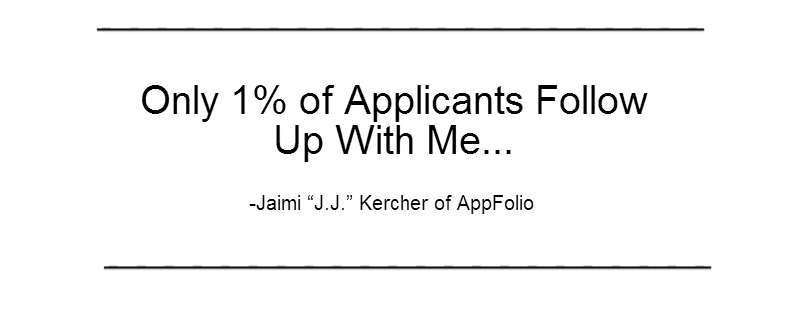On the job front it’s your first impression—even before the new dress, spiffy suit and Tic Tacs. So why in this competitive, modern age are people still making mistakes on their cover letter and resume?
“It shows me their interest and motivation for the position,” says Human Resources V.P. Julie Lamb, whose company Wagner Cuban does hiring at seven divisions including Magnolia Pictures. And when it comes to selling yourself, if you’re not picky about presentation then you better keep reading.
“As an example, after a 10-day vacation I came back to 89 new resumes,” said Jaimi “J.J.” Kercher of Golita-based AppFolio. “I was able to eliminate nearly half of them by just scanning through” the cover letters.
Bottom line: it’s too competitive out there to cut corners, so we asked Lamb and Kercher, who is currently hiring to double AppFolio’s UX design team, for advice on what works—and what doesn’t.
1. Don't Make it too General--Generic is for Prescriptions
Generic cover letters are a huge turnoff. Sure, you may be sending out dozens of them but you’re making it real easy for a manager to pare down that huge stack.
“If they send a generic cover letter,” says Lamb, “then it tells me they are just applying for any position rather than spending the time researching my role and specifically targeting the position I am hiring for.”
“Talk to me about how eager you are to learn and apply specific aspects of the job description,” says Kercher. “Like Lean/Agile UX and cross-functional collaboration. In short, I want to sense your excitement about the opportunity.”
Do this: Tailor your cover letter not only to the specific position, but if possible, find out who is doing the hiring for that job and address it to him/her. Says Kercher: “It takes a simple Google or LinkedIn search of ‘AppFolio UX’ to find out who is hiring.”
2. Don't Be Too Lengthy--It's Not Your Memoir
No one likes getting cornered at the party listening to an endless, boring story. Consider that the hiring manager may feel the same way reading your cover letter.
“It should just highlight information relevant to the particular position,” says Lamb, “not a full summary of their whole career.”
And for Kercher that includes the digital turnoff of “links to everything you’ve worked on—ever,” she says. “And the first link is broken!”
Do this: Craft a cover letter that draws the hiring manager into your accomplishments, not your full history. It should weave in basic employment facts so the manager knows you are qualified, but it should go further to impress them with your actions and leave them craving more.
3. Don't Make it All About You--What Have You Done for Me?
If you were a designer, you designed. If you were in sales, you sold. The hiring manager gets that much. So when describing your duties on your resume go deeper.
Says Lamb: “I would much prefer someone tell me that they increased sales by X-percent by implementing (exhibit A) than just tell me that they were responsible for selling.”
Do this: Turn passive lines on your resume into active ones. Chances are you can turn “designed” into some variation of “designed projects that changed the world.” (and you might also get a Nobel prize)
4. Creative is Good, Clean is Better
If it’s a creative position then a hiring manager will have a higher tolerance for creativity on a resume.
“(For most positions) style does not need to be anything other than professional and easy to read,” says Lamb. “If, however, the style is not consistent, not formatted well, too long or difficult to read then it would be screened out.”
Kercher agrees, but adds that given two similar candidates style can give one a leg up in a creative position.
“It is our job to communicate information in a logical, cohesive and delightful way,” she says. “It’s all about how quickly your ‘user’ can get a sense of your talents and experience.”
Do this: No matter how much style you put into a resume, consider its navigational flow. If the hiring manager has to do too much work to get the basics, then you may need to scale back or reformat. If you’re not going for a creative position, it may not be worth the risk.
5. Don't Forget to Triple Check Everything--Housekeeping Matters
A common theme in talking to hiring managers is that spelling and grammar mistakes still happen, so make sure it’s not happening to you.
Lamb says “missing employment dates” are also common, as is “only listing an email address especially for positions where relocation is not being considered.”
Do this: Go deeper than “spell check.” Have someone else read your work to make sure everything is grammatically correct and clear. You might think something makes sense but a fresh pair of eyes may have a different take.
6. Don't Forget to Follow Up

If your resume is short on experience, then the cover letter becomes your best friend. Use it to fill in the gaps with enthusiasm and knowledge of the company.
“Any cover letter that conveys a specific enthusiasm about why the applicant wants to work at our company immediately bubbles up regardless of the resume,” says Kercher.
Do this: Follow up (email only!) after you’ve submitted your resume so your eagerness overshadows any shortcomings in your experience. Kercher says she’s shocked that about only one percent of applicants follow up with her. “Since that number is so low, that definitely stands out in my book.”













